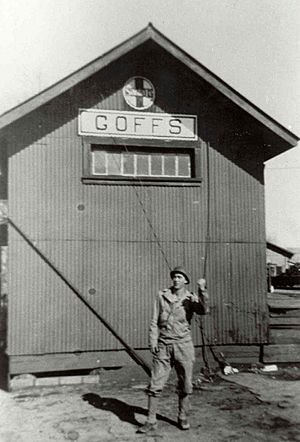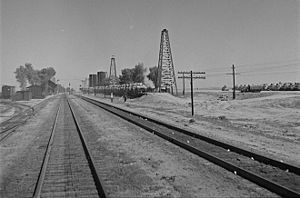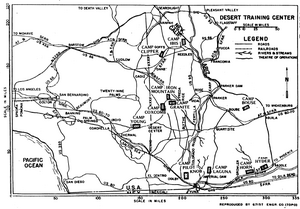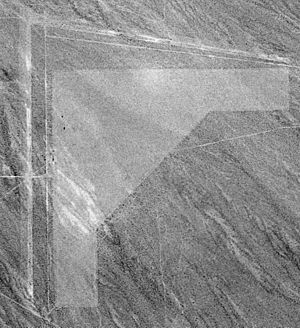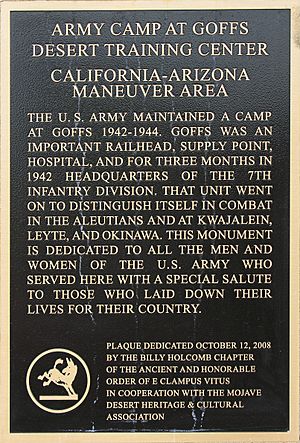Camp Goffs facts for kids
Camp Goffs was a special training camp for the United States Army during World War II. It was located in the desert of Riverside County, California. This camp was part of a much larger training area called the Desert Training Center. The main base for this center was Camp Young, where General Patton and his soldiers trained.
Camp Goffs is recognized as a California Historical Landmark (No. 985). It was built near the old Santa Fe Railroad station in Goffs, California. Goffs is a small place on U.S. Route 66, about 25 miles (40 km) west of Needles. Today, it's located at the southeast edge of the Mojave National Preserve.
Contents
Why Was Camp Goffs Built?
Camp Goffs was built in 1942. Its main goal was to get American troops ready for battle in World War II. Soldiers needed to learn how to fight in harsh desert conditions.
When the camp was finished, it had many important buildings. These included shower buildings and latrines (bathrooms). There were also wooden frames for tents where the soldiers slept. A large water tank provided fresh water. The camp also had special areas for firing practice.
Camp Goffs was also home to a large supply area. This was called the Goffs Army Ammunition Depot #4. For safety, the ammunition was stored about 3 miles (4.8 km) south of the main camp.
About 15,000 troops trained at Camp Goffs. One of the main groups that trained there was the 7th Infantry Division. The camp closed down in May 1944 after its mission was complete.
Who Trained at Camp Goffs?
Many different types of army units trained at Camp Goffs. These units helped the main fighting forces. They included:
- Units that helped move supplies.
- Groups that fixed vehicles and equipment.
- Companies that handled ammunition.
- Teams that provided laundry services.
- Medical units, like the 51st Evacuation Hospital.
These units learned how to work together in the desert. This training was very important for their future missions.
The 51st Evacuation Hospital's Journey
The 51st Evacuation Hospital was a special army hospital. It was started by Dr. Orrin S. Cook, a veteran from World War I. He wanted to create an army field hospital in Sacramento, California.
The hospital officially began in September 1942. It moved to different places for training. In April 1943, it arrived at Camp Goffs. Here, it supported the soldiers training in the desert. This hospital could care for up to 750 patients.
Later, the 51st Evacuation Hospital moved to other locations. It went to Camp San Luis Obispo and Camp Cooke in California. In March 1944, it prepared to go overseas. The unit traveled by ship for 23 days to Oran, Algeria.
After two months, the hospital moved to Naples, Italy. They set up a hospital at the Naples Fair Grounds. They continued to move with the war, setting up hospitals in different towns in France and Germany. They helped wounded soldiers until October 1945. Finally, they were sent home.
Camp Goffs Army Airfield
Near Camp Goffs, there was an old civilian airfield. It was turned into the Camp Goffs Army Airfield. This airfield was about two miles northeast of the camp.
The airfield helped support the training activities. It was also used for the supply depot. Small planes, like the L-4 Piper Aircraft, used the runway. These planes could watch over the large training grounds from the sky.
At its busiest, the airfield was made bigger. It had two runways, each 4,700 feet long. This allowed larger military planes to use the field. After Camp Goffs closed in 1944, the airfield was no longer used.
A Special Marker at Camp Goffs
There is a special marker at the site of Camp Goffs. It is Marker 136. It tells us about the camp's history:
- The U.S. Army had a camp at Goffs from 1942 to 1944.
- Goffs was a key place for supplies by train. It also had a hospital.
- For three months in 1942, it was the headquarters for the 7th Infantry Division.
- This division fought bravely in places like the Aleutians, Kwajalein, Leyte, and Okinawa.
- The marker honors all the men and women who served there. It especially remembers those who gave their lives for their country.
This marker was put up in 2008. It was placed by the Billy Holcomb Chapter E Clampus Vitus and the Mojave Desert Heritage & Cultural Association.
About Goffs, California
Goffs, California, is a small, quiet community today. It's in San Bernardino County, California. The Santa Fe Railroad first built it as a rail station in the Mojave desert. Railroad workers lived there.
Before 1931, Goffs was a busy stop on the famous Route 66. Then, a more direct road was built, and Goffs became quieter. Nearby towns include Homer to the east and Fenner to the southwest.
From 1893 to 1902, Goffs was called Blake. This was after Isaac Blake, who built a railway there.
To serve the travelers and railroad workers, there was a large general store. It is now abandoned. In 1914, a schoolhouse was built for the children of the workers. This schoolhouse is now a museum. It's called the Mojave Desert Heritage and Cultural Association (MDHCA). It shows items from mining and military history. Many old mines are also found around Goffs.
Images for kids


